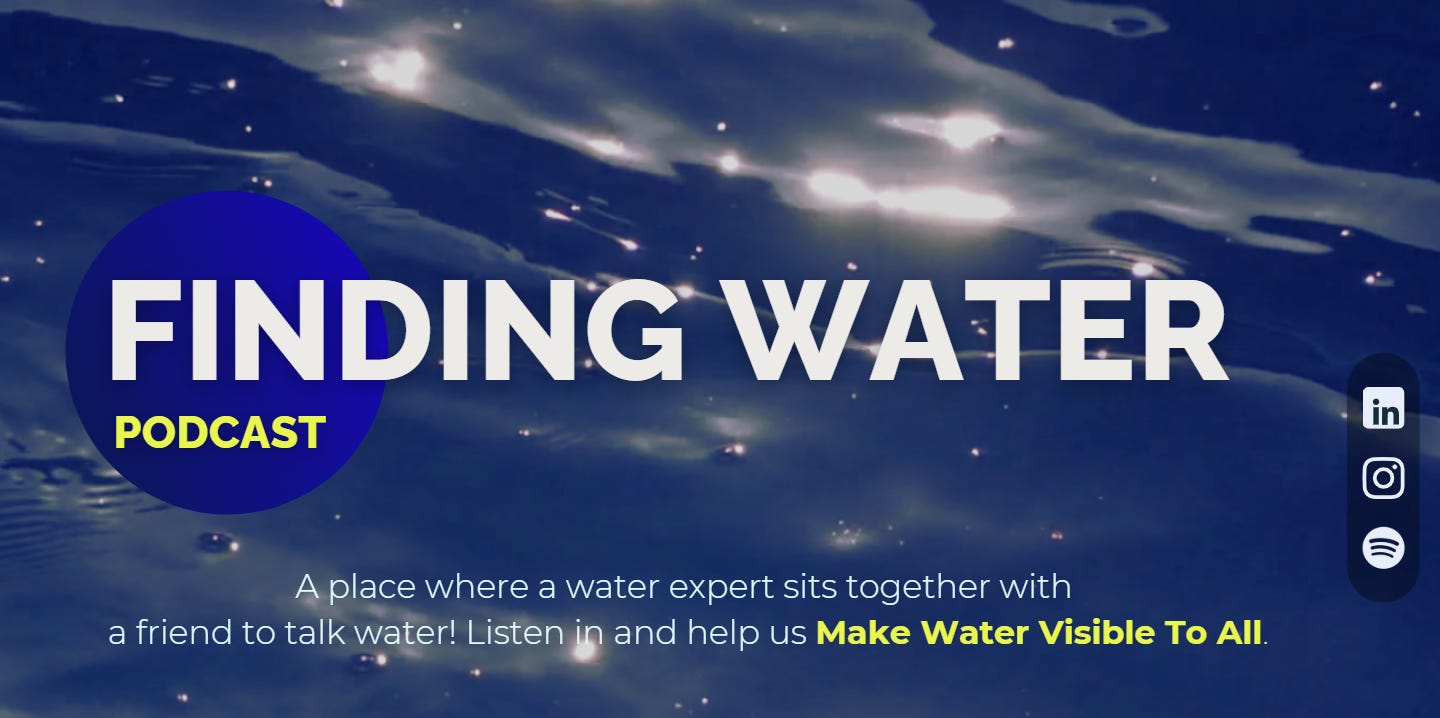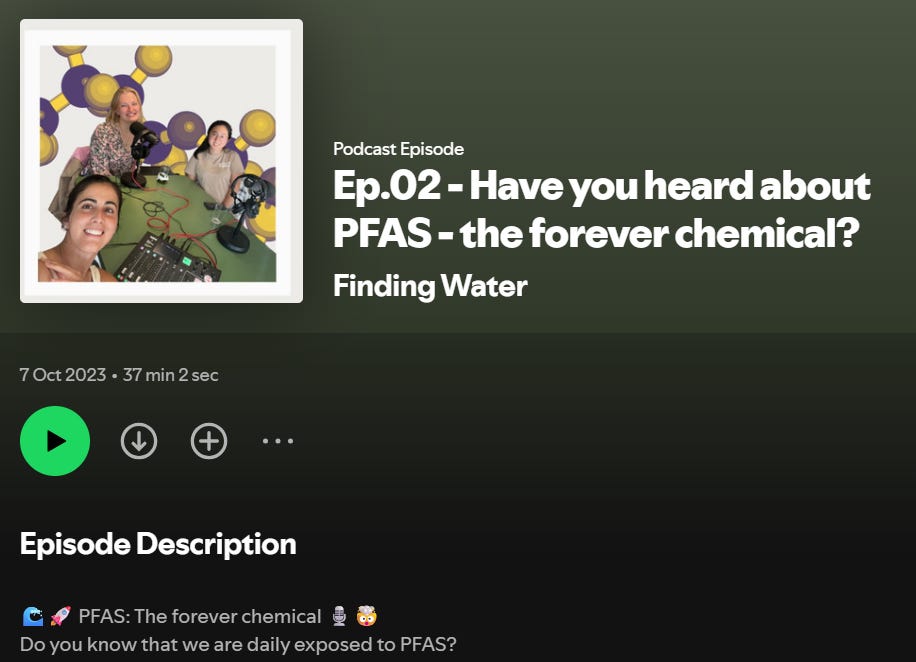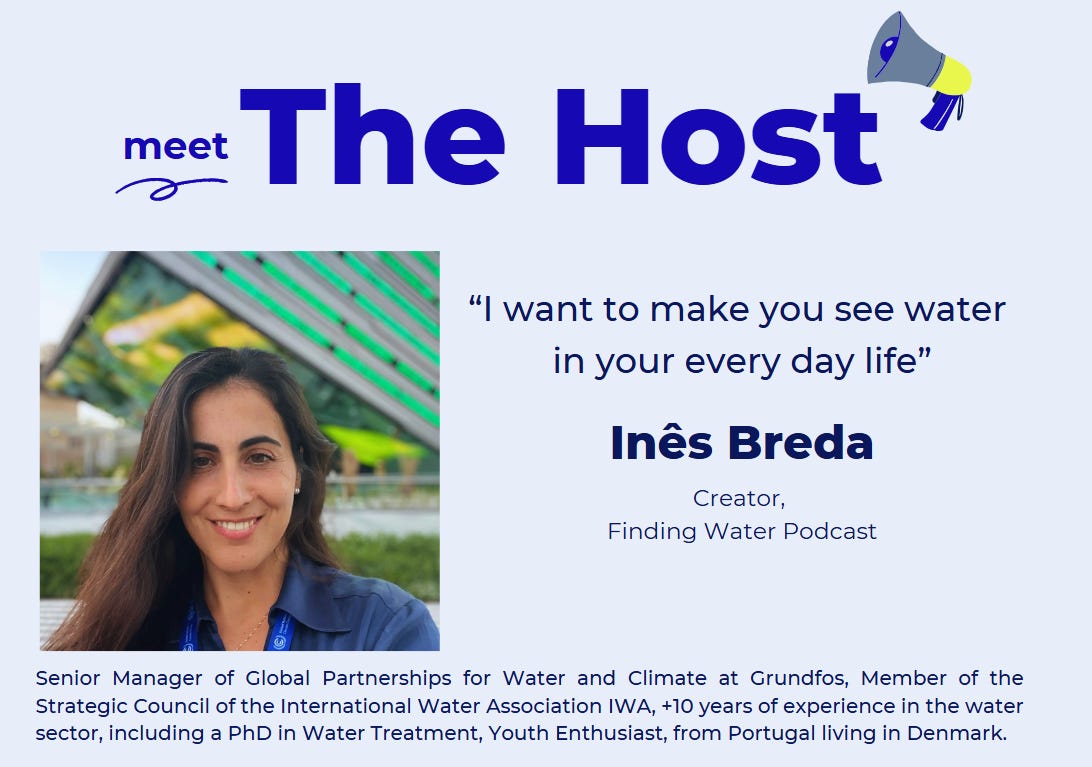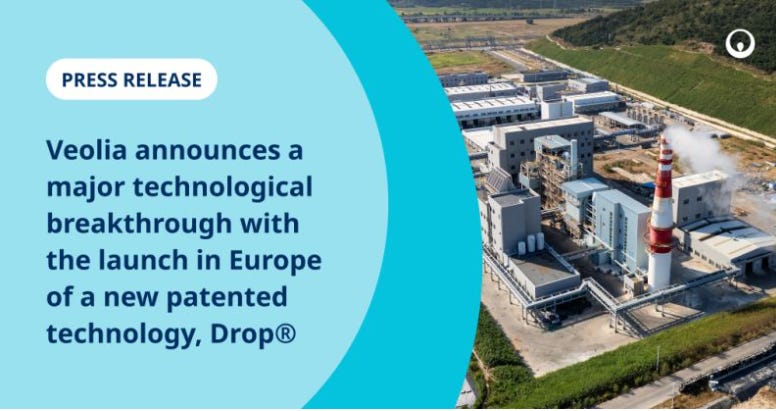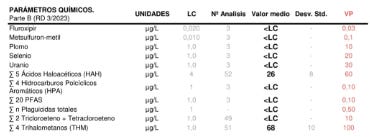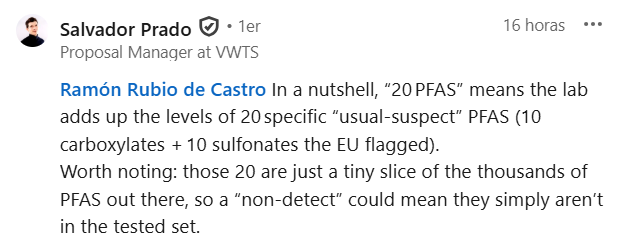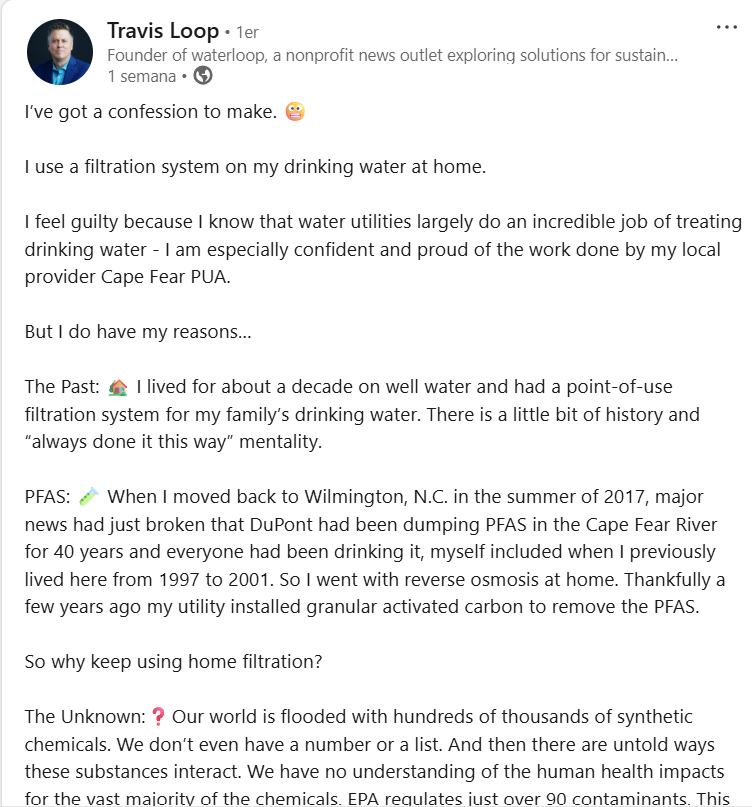Finding Water with Ines Breda
Discovering a passionate professional shaping the water sector. What PFAS are and why they matter.
One of our most viewed and engaging episodes features our conversation with Ines Breda, the amazing host of the Finding Water podcast, and a key member of the Grundfos team and the Strategic Council of IWA.
As I began my journey of building our "Water MBA" over the coming years, I came across the term PFAS.
I had no idea what it was. So I did what anyone would do: I googled it, searched LinkedIn and Spotify, "PFAS"
That’s when I found this episode. I thought, “I’ve never even heard of this, that’s exactly why I’m searching.”
I was immediately drawn in by Ines’ passion and the warm, approachable tone of the conversation.
I picked up a few key insights about PFAS, which gave me a foundation to continue exploring and learning more.
One thing led to another.
I saw on LinkedIn that Ines had an impressive background in the water sector, and she stood out for her strong presence and excellent communication skills.
At the same time, I was in conversation with Cristian Carboni from Water Europe.
While exploring their YouTube channel, I came across a video featuring Ines in one of their playlists.
Through that video, I learned more about the water stress issues affecting Southern Europe and started to better understand the dynamics behind the way things are evolving.
So, I didn’t hesitate to invite Ines to be part of The Water MBA.
I wanted to meet her “personally”, and more importantly, I wanted our community to have her as a key reference point when seeking knowledge or connections in the global water space.
Since then, one of my favorite initiatives that Ines has introduced is Water Wednesdays.
I’m not a big fan of Instagram myself, The Water MBA hasn’t gained much traction there, so I don’t use it often to engage or post.
But every week, when I do check my feed, I find Ines’ weekly video, and it’s really good.
I mean that sincerely.
It’s an outstanding example of communication and raising awareness, making water issues visible and accessible to everyone, not just water professionals. I’m serious, it’s fantastic work.
If you’re on Instagram, I highly recommend adding her to your feed.
What did I learn from our episode with Ines?
First, I learned that there are truly amazing professionals and human beings out there.
It gave me hope and motivation to stay in this industry and keep connecting with like-minded individuals.
Second, I gained a clearer understanding of the PFAS issue in the U.S., how it emerged a few years ago and reached a point where the EPA had to step in.
Of course, it’s a multifactorial issue, but that intervention marked a significant milestone in public awareness and policy.
Third, I discovered why Ines started her podcast, on her own time, during her free hours. I really related to that.
We come from different paths, but the motivation behind creating something meaningful in your spare time felt very familiar.
We also touched on the broader challenges the world is facing when it comes to water, complementing perspectives from other guests in a really engaging way.
I feel truly lucky to have had Ines on The Water MBA.
She’s now a valuable reference point for our community, someone you should absolutely include in your learning journey over the next few years.
And beyond her expertise, she’s also the kind of person you could say hi to at an event, share a drink with, and have a genuinely friendly conversation.
Grundfos, one of the biggest pump players
It is well-known, but it's important to pay attention to subtle details in M&A activity.
Over the past five years, Grundfos has pursued strategic acquisitions beyond its core pump portfolio.
Why?
Because this is what makes the water sector so interesting, companies and strategies can adapt and pivot.
Let me give you an example.
Grundfos acquired Newterra. No financial details were disclosed in the press releases; both Grundfos and Frontenac chose to keep the purchase price confidential.
The deal is expected to close in the second half of 2025, pending regulatory approvals.
What is Newterra’s expertise?
Modular & decentralized water treatment: designs, engineers, manufactures, and services systems for potable water, industrial water, wastewater, stormwater, groundwater remediation, and PFAS treatment
Broad tech toolkit: MBR, RO, UV, ion exchange, aeration, oxidation
Full life‑cycle services: engineering, rentals, media exchange, IoT, maintenance
Water‑as‑a‑Service fit: clear alignment via rental, media-exchange, monitoring, and service contracts
Modular and water-as-a-service (remember our episode number #45 with Marcos de la Monja and BioDaf)…so this is decentralised waste water treatment…
Imagine you're an industry, say food & beverage, pharmaceuticals, or any other sector where water is critical to your production.
You realize you can no longer rely solely on the pace and development of municipal or public water infrastructure.
Water is simply too important to leave to chance.
So, you turn to private third-party providers and say:
“I need a solution that ensures water is not a bottleneck for my operations. I don’t want to depend on new infrastructure rollouts, deal with all the capex, staffing, credit, or debt. Just bring me a reliable, ready-to-go solution, and I’ll pay per use.”
Maybe it's a temporary fix while you sort things out internally.
Or maybe it's your long-term strategy to secure water as a stable, predictable input, so you can focus on other parts of your process and avoid disruptions caused by local water shortages or infrastructure delays.
This is the reality: industries “desperately” need water, and they want solutions now.
Decentralized water systems are increasingly emerging as a strong fit for these needs, especially in the short to mid-term.
PFAS, what?
PFAS, per- and polyfluoroalkyl substances, comprise a large group of synthetic chemicals.
Estimates suggest there are thousands of different PFAS compounds, often referred to as "forever chemicals" due to their persistence in the environment and the human body.
But when did PFAS first enter the conversation?
The term has been around for decades, though it remained under the radar for a long time.
Used since the 1940s in products like non-stick cookware (Teflon), water-repellent clothing, stain-resistant fabrics, food packaging, and firefighting foams.
PFAS contamination was mostly overlooked, but scientific evidence linked them to health problems like cancer, liver damage, immune system issues, and developmental effects in children.
The EPA's turning point came after growing public pressure, media investigations (like the 2018 film Dark Waters, REALLY GOOD ONE by the way!), and emerging scientific research.
In 2022, the EPA issued updated health advisories for several PFAS chemicals — like PFOA and PFOS — at levels “near zero”, reflecting how dangerous even tiny amounts can be.
In March 2023, the EPA proposed the first-ever national drinking water standards for six PFAS.
Now it’s not clear if they will remove or keep them. This is constantly evolving.
It’s a silent enemy. And I’ll be honest, I’m even looking into how to test my own blood for PFAS (without success so far).
If this is something that’s “killing me softly,” I want to know.
But then the big question arises: what if tolerances and effects are nearly impossible to clearly define?
Like many things in health and the environment, it's multifactorial.
One thing is clear: PFAS aren’t good. But we also need to frame the issue properly and put it in context.
After all, even breathing, depending on where and how, can harm us. Life isn’t black and white.
What really fascinates me is how PFAS regulation will evolve, how major industry players will position themselves (take a look at Veolia below…), and how water tech innovation will respond in the coming years.
“📣 Veolia announces a major technological breakthrough with the launch in Europe of a new patented #technology, Drop®, effective to achieve up to 99.9999% destruction of targeted #PFAS, through an incineration process at over 900°C.”
We’re just at the beginning of this story, and it’s one worth following closely.
By the way, speaking of the EPA and PFAS, I also get my weekly dose of insights straight from the horse’s mouth, directly from…Mohamed Ateia Ibrahim in the newsletter of NextDrop Solutions.
PFAS in my tap?
I recently visited a Drinking Water Treatment Plant in Spain. During the visit, I was surprised to hear the plant chief say:
“We’re starting to analyze 20 PFAS compounds in an external laboratory.”
My first reaction was: 20 PFAS? That’s quite a lot, especially considering that the U.S. EPA currently focuses on just 6 PFAS compounds for regulatory limits.
Later, I realized it was simply the scope defined by the external laboratory performing the testing.
There’s still uncertainty about how many compounds to monitor, what risks they pose, and what action should follow.
For context, here’s an example of the public water quality data from the tap water in my area, with 20 PFAS reference and 3 analytics.
Thanks to a conversation with a fellow member of our community, Salvador Prado, I came to understand what this actually means:
We’ll have a deeper dive into how to treat (remove or destroy) PFAS in next weeks.
A treatment to remove PFAS can obtain a reduction in long-chain type, but the short-chain type remains the same.
So this means that the long-chain are simply being splited in short-chain? or it means that the treatment is effective in long-chain but not in short-chain?
PFAS, how do we communicate?
To be honest, I find it very unlikely that our society will fully grasp the concern around contaminants like PFAS.
In the U.S., public awareness might be higher because of well-known cases and media coverage.
But trust me, here in Spain, hardly anyone talks about it.
The topic is too grey, too technical, and too complex even for many specialists.
So how can we expect the general public to understand that further treatment is needed, and that this must be reflected in the water tariff?
How do we communicate the health risks of these contaminants when the consequences are long-term, subtle, and often part of multifactorial health issues?
But despite this complexity, we must not hesitate.
As water professionals, we have a responsibility, a duty, to pursue the highest possible water quality for future generations.
No matter how difficult, how invisible, or how small the contaminants are.
No matter how challenging it is to explain or justify the costs. We owe it to the next generation to take action now.
Should I be worried?
I believe we, as professionals in the water industry, have many open fronts to improve on.
At the very least, each of us should understand where our own drinking water comes from.
Personally, I don’t feel particularly threatened by PFAS in my area.
Our raw water source comes from the mountains, with very few upstream wastewater discharges and no significant industrial activity that would contaminate it.
In my local context, the bigger challenges are the aging water infrastructure and the quality of nearby rivers, although those rivers aren’t the main source for my city’s drinking water.
I remember a triathlon I participated in about seven years ago.
The water in that river was quite dirty.
There were concerns at the time about high E. coli levels and whether it was even safe to swim—similar to the issues we've seen around the Olympic Games in Paris.
Whether it was from exertion or accidentally ingesting some of that water, I ended up with stomach pain and diarrhea for a couple of days afterward.
Take, for example, Travis Loop, one of our most well-known voices in water media.
He lives right at the epicenter of the PFAS story. (I’ll be sharing an episode about this in the coming weeks).
Below is a brief excerpt of what he said, including the steps he took, such as installing various filtration systems in his home, and a summary table with key dates and milestones in the PFAS timeline.
This week’s LinkedIn Wednesday article
If you missed our LinkedIn article this Wednesday, it was about flood defense.
Read the article clicking here.


